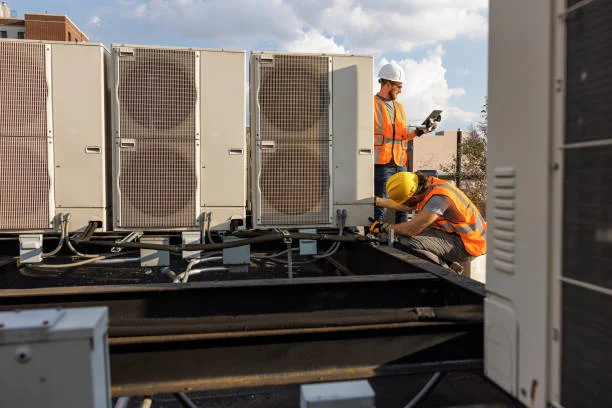Energy efficiency has become one of the top priorities in new home construction. As building codes evolve and homeowners look for ways to reduce utility costs and environmental impact, energy-efficient design is no longer optional—it’s a standard expectation. While insulation, windows, and lighting are often the first elements considered, heating, ventilation, and air conditioning systems play a crucial role in overall performance. The HVAC setup determines how effectively a home maintains its climate while consuming as little energy as possible. From system selection to duct layout and thermostat placement, every detail matters when designing a house built for efficiency. Proper planning ensures that heating and cooling systems don’t overwork or underperform, ultimately reducing energy bills and enhancing comfort. Contractors involved in HVAC work help bridge the gap between design and real-world functionality, ensuring that the final installation supports comfort and sustainability from day one.
Designing for Comfort While Meeting Energy Goals
Planning HVAC for Efficiency from the Ground Up
When constructing a new home with energy efficiency in mind, HVAC decisions begin during the planning phase. This means integrating heating and cooling strategies into the architectural design rather than treating them as an afterthought. A properly designed HVAC system considers the home’s orientation, the size and placement of windows, room usage, insulation levels, and expected occupancy. These factors influence everything from the system size to the type of equipment selected. Zoning may be incorporated to tailor climate control for different areas, while duct placement is optimized to reduce air leakage and maintain steady airflow. During this phase, collaboration between builders and a qualified HVAC contractor becomes essential, ensuring the home’s climate system is both efficient and compatible with the rest of the structure. Early involvement also allows for smart planning of returns, vents, and mechanical rooms, which helps avoid last-minute compromises that could affect system performance.
System Selection and Equipment Considerations
Choosing the right heating and cooling equipment is central to achieving a home’s energy goals. Not all systems perform equally in every environment, so contractors assess local climate conditions, insulation levels, and home size before making recommendations. For example, a well-insulated home in a temperate climate might benefit from a heat pump system, which provides efficient heating and cooling in one unit. Homes in colder regions may require dual-fuel systems that combine electric and gas elements for seasonal efficiency. In both cases, selecting ENERGY STAR-rated appliances helps ensure reduced energy consumption without sacrificing performance. Beyond the primary unit, contractors may also suggest variable-speed blowers, smart thermostats, and sealed ductwork to improve efficiency further. These components work together to reduce runtime, maintain steady indoor temperatures, and lower long-term utility expenses. Making the right equipment decisions during construction helps homeowners avoid expensive upgrades later and ensures the home functions at its highest potential from day one.
Explore related articles to deepen your understanding before you go.
Ductwork Design and Airflow Management
Even the most efficient HVAC equipment can fall short if the ductwork isn’t properly designed. Ducts must be strategically sized and placed to distribute air evenly and avoid pressure imbalances throughout the home. Poorly designed duct systems lead to temperature inconsistencies, energy loss, and increased heating or cooling unit strain. During new construction, contractors have the opportunity to plan duct layouts that are both efficient and inconspicuous, hiding them within walls, floors, or ceilings without compromising access for maintenance. Proper sealing of joints and insulation of ducts are also critical, particularly in unconditioned spaces like attics or crawl spaces. These steps help prevent air leakage and temperature fluctuations, reducing waste and maximizing comfort. Good airflow also supports healthy indoor air quality, an increasingly important factor in energy-efficient home designs. Air returns and ventilation points must be balanced to ensure fresh air circulation while maintaining indoor climate consistency.
Smart Controls and Integration for Long-Term Savings
Technology plays a vital role in maintaining energy efficiency after construction is complete. Smart thermostats, sensors, and automated controls can drastically improve how a home uses energy daily. These tools allow homeowners to schedule heating and cooling based on usage, occupancy, or weather patterns. Thermostats can learn habits and adjust settings accordingly, reducing energy waste without sacrificing comfort. During the construction process, HVAC contractors can coordinate the installation of these controls along with the central system, ensuring seamless integration and reducing the need for retrofits. Additionally, many smart systems can monitor performance and detect irregularities early, allowing for preventative maintenance that keeps the system running smoothly. With the rising popularity of home automation, efficient HVAC systems are increasingly becoming part of a larger network of interconnected devices, all working toward optimized energy use. Smart integration supports not just comfort but also long-term affordability and environmental responsibility.
Energy Ratings, Testing, and Final Adjustments
Once the HVAC system is installed, the job isn’t finished. Contractors conduct tests to verify that the system performs as expected and meets energy-efficiency standards. This may include duct leakage testing, airflow measurements, and system balancing to ensure every part of the home receives the correct amount of conditioned air. Builders may also pursue energy ratings such as HERS (Home Energy Rating System) to validate the home’s overall efficiency, and HVAC contractors play a key role in helping meet those requirements. Final adjustments often involve calibrating thermostats, checking refrigerant levels, and confirming that all controls function properly. These final steps are essential in closing the loop between design and performance of HVAC Contractors. A home that tests well from the start is more likely to deliver on its energy-saving promises for years. Through testing and verification, contractors not only complete their job, they help ensure the long-term success of the entire energy-efficient design.
A Long-Term Commitment to Comfort and Efficiency
Energy-efficient construction is a growing priority in residential development, and HVAC systems are central to achieving these goals. From the first drafts of architectural plans to the final system test, every decision contractors make affects how well the home will perform in the future. When HVAC systems are designed with efficiency, comfort, and sustainability, homeowners benefit from lower energy bills, more consistent indoor temperatures, and fewer system failures. More importantly, these systems support a healthier environment by reducing carbon emissions and energy waste. The role of the HVAC team for HVAC Contractors is not just technical—it’s collaborative and future-focused, involving coordination with builders, architects, and homeowners alike. By embedding efficiency into the very foundation of a home, contractors make a lasting impact that extends far beyond installation day. With each energy-conscious project, they help shape communities better prepared for modern living demands.
You’ll find even more guides and resources on 2A Magazine .







